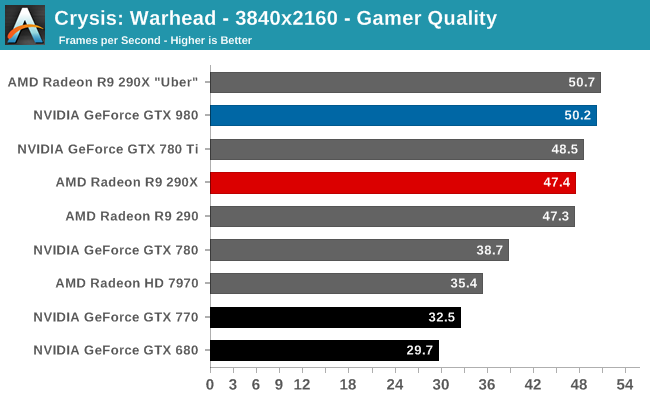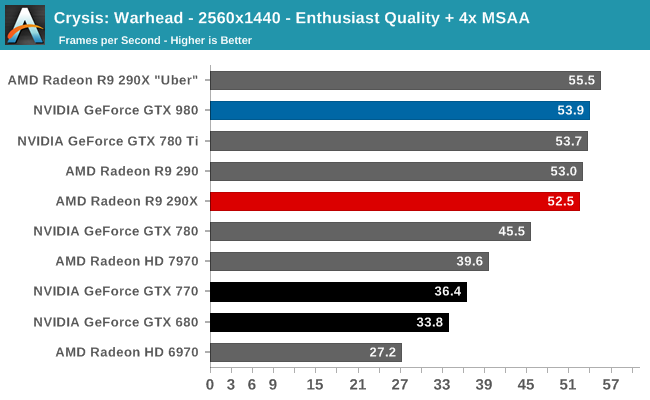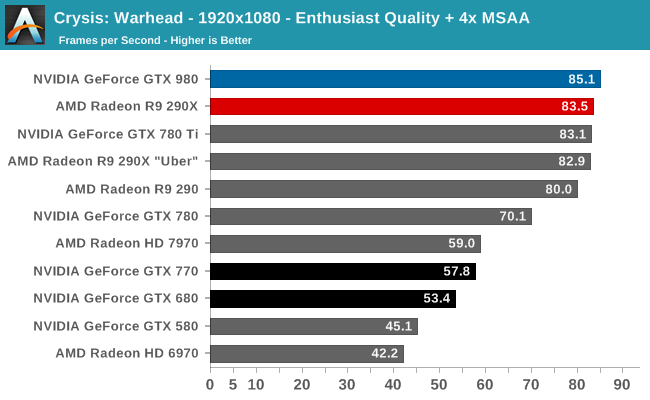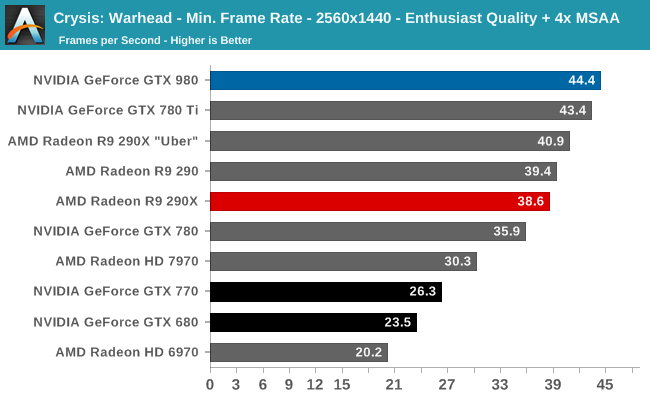The NVIDIA GeForce GTX 980 Review: Maxwell Mark 2
by Ryan Smith on September 18, 2014 10:30 PM ESTCrysis: Warhead
Up next is our legacy title for 2014, Crysis: Warhead. The stand-alone expansion to 2007’s Crysis, at over 5 years old Crysis: Warhead can still beat most systems down. Crysis was intended to be future-looking as far as performance and visual quality goes, and it has clearly achieved that. We’ve only finally reached the point where single-GPU cards have come out that can hit 60fps at 1920 with 4xAA, never mind 2560 and beyond.



At the launch of the GTX 680, Crysis: Warhead was rather punishing of the GTX 680’s decreased memory bandwidth versus GTX 580. The GTX 680 was faster than the GTX 580, but the gains weren’t as great as what we saw elsewhere. For this reason the fact that the GTX 980 can hold a 60% lead over the GTX 680 is particularly important because it means that NVIDIA’s 3rd generation delta color compression is working and working well. This has allowed NVIDIA to overcome quite a bit of memory bandwidth bottlenecking in this game and push performance higher.
That said, since GTX 780 Ti has a full 50% more memory bandwidth, it’s telling that GTX 780 Ti and GTX 980 are virtually tied in this benchmark. Crysis: Warhead will gladly still take what memory bandwidth it can get from NVIDIA cards.
Otherwise against AMD cards this is the other game where GTX 980 can’t cleanly defeat R9 290XU. These cards are virtually tied, with AMD edging out NVIDIA in two of three tests. Given their differing architectures I’m hesitant to say this is a memory bandwidth factor as well, but if it were then R9 290XU has a very big memory bandwidth advantage going into this.



When it comes to minimum framerates the story is much the same, with the GTX 980 and AMD trading places. Though it’s interesting to note that the GTX 980 is doing rather well against the GTX 680 here; that memory bandwidth advantage would appear to really be paying off with minimum framterates.










274 Comments
View All Comments
ppi - Saturday, September 20, 2014 - link
AMD will not beat 980 (they probably could put some fight, but nVidia could always defend it easily, so why do that - it would just dilute prices). What is more important for them, that *on desktop*, AMD can still stay relevant in lower price buckets by offering more performance per $ (while relying on partners for custom open-air cooling and ignoring the power draw disadvantage).Kjella - Sunday, September 21, 2014 - link
You do realize what you said pretty much exactly mirrors what people said about AMD and CPUs a few years back? Just trying to offer value while your competitor is making more efficient chips is a dead end where you're soon so far behind in technology that it's not enough. Nobody wants a 220W CPU (FX-9370/9590) and if AMD needs to pull a 300+W GPU to compete with GTX 980 it'll be equally dead on arrival.ppi - Sunday, September 21, 2014 - link
Not really. When Core2 was released, pretty much entire AMD's lineup was made irrelevant (I still use my 7 years old mid-range Core2Duo and I know that AMD chips were not even for consideration back then). Now the fastest AMD's card is faster than 2nd fastest nVidia offering. Look at TR 2014 HW survey where 80% clearly enthusiasts buy stuff for less than $400. Die sizes are similar. Both companies are fabless and thus have access to the same processes (unlike competition with Intel).AMD of course HAS TO come up with something better than what they have now. And soon. My point was mainly that they should be able to survive this holiday season sort of okayish.
I expect that AMD is focusing their limited resources on 20nm part, but it apparently did not work as well as it did in times of HD-5000 and 7000 series. And Maxwell improvements are greater than what is achievable just with die shrink. So there's some hard work for AMD ahead. Given necessary lead time for such products, I doubt 300-series will be good enough (unless they were going nuts with efficiency after seeing 680).
I admire nVidia for a long time always covering weak spots in their products. It could be seen from times when they went against 3dfx, though FX-5000 and now of course they show how they learned from 480 era.
Silma - Saturday, September 20, 2014 - link
I fully agree.As long as Intel does not succeed better in smartphones & tablets, it probably doesn't fully utilize its manufacturing capacities.
It could begin with opening 22 nm to NVIDIA and 14nm in 2015.
Seriously though, I'm not sure why Intel still hasn't bought NVIDIA, except if it foresees troubles getting the deal accepted with regulators.
This would not Mirror the AMD's ATI acquisition. crap + crap = crap.
Outstanding + outstanding = awesome.
Notmyusualid - Saturday, September 20, 2014 - link
+1SanX - Sunday, September 21, 2014 - link
Intel should buy NVIDIA long ago but they are in lethargy all last dacadeRyan Smith - Thursday, September 18, 2014 - link
BTW, before anyone asks: we're still working to get images and charts in. 4 days is very little time for a 20K word article. So please hold on for a bit.boot318 - Thursday, September 18, 2014 - link
Where is the Overclocking results? Not done yet? I see the page but it is blank.RaistlinZ - Thursday, September 18, 2014 - link
Ditto. I can't see the overclocking page.chizow - Thursday, September 18, 2014 - link
And no 970 results?